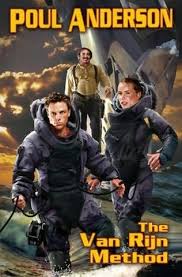Poul Anderson's Time Patrol series, complete in one omnibus collection and one long novel, begins when Manson Everard is recruited into the Time Patrol in New York, 1955, and ends when Unattached Agent Everard, having just begun a relationship with Patrol Specialist Wanda Tamberly in San Francisco, 1990, has also just completed a mission to Paris, 1307. However, Wanda trained at the Patrol Academy in 31, 275, 389 BC. Further, a million years after the twentieth century, humanity will have evolved into the Danellians who will found the Time Patrol when time travel is discovered in 19352 AD. In the early twenty fourth century, an Unattached agent will live on Venus and a Patrol physician will work on the Moon. Time criminals are sent to an exile planet. Thus, the series presents a vast panorama of space and time although mainly of time.
Anderson's History of Technic Civilization, complete in seven omnibus collections, begins with the exploration of the Saturnian system about 2055 AD and ends with the exploration of the Cloud Universe star cluster in 7100, when mankind has spread through three spiral arms. An earlier star-faring race became extinct in the galactic past, leaving a legacy of ruins with inscriptions and of small organisms that are telepathic parasites. Thus, the History presents a vast panorama of space and time but mainly of space.

8 comments:
Kaor, Paul!
And I think exploration of space and the settling of other worlds to be more plausible than time traveling. Altho I have read about people who argue that a FTL drive necessarily means time traveling as well. I know too little about speculative physics to comment either way about that.
Sean
"The Long Way Home" features a FTL drive that allows a ship to cross interstellar distances instantaneously. But only as far as the ship in concerned. As far as the rest of the Universe is concerned, it's travelling at the speed of light. .
Hi, John!
Darn! I forgot about that one! Thanks for reminding me.
Sean
John and Sean (two forms of the same name),
There are two points here. PA imagined a ship that traveled at light speed in objective time but instantaneously for its passengers but some people argue that a ship that traveled faster than light in objective time would also go backwards in objective time.
Paul.
Kaor,l Paul!
Yes, John and Sean are variants of the same name! (Smiles) Ultimately, it goes back to the Hebrew "Johanan."
Where did you find these comments by PA that a ship using a drive which drove a ship only at light speed in objective time but was FTL for its passengers? And then he said that a ship which traveled FTL in objective would also go backwards in time? Was it STARFARERS? It's interesting enough that I would like to look it up.
Sean
Sean,
We may be getting a bit mixed up here. The spaceship in THE LONG WAY HOME travels at light speed (e.g., takes four years to cross the four light years to Proxima Centauri) although its crew endure and experience no duration during those four years. When I said that some people argue that an FTL ship would go backwards in time, I was simply referring to your own 3rd last comment to this post.
Paul.
Kaor, Paul!
Understood! Thanks. I had in mind the bit in STARFARERS, about the crew of "Envoy" somehow getting messages from the future.
Sean
I would like to see more SF using a lightspeed drive like that in "The Long Way Home".
It makes interstellar colonization relatively easy, but makes for interesting divergence in the societies in different solar systems.
The almost light speed drive of Kith/Starfarers makes for a similar interstellar system.
Some time ago there was a series of short stories in Analog with a lightspeed drive & some people trying to set up a rather creepy sort of interstellar empire despite the necessarily slow communication.
Does anyone know of other SF with a lightspeed drive?
Post a Comment